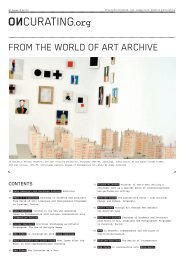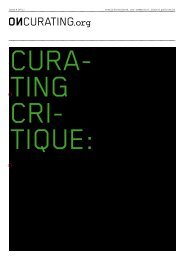Create successful ePaper yourself
Turn your PDF publications into a flip-book with our unique Google optimized e-Paper software.
057 Issue # 11/11 : PublIc Issues<br />
see anew while reinspecting routine and banal elements of<br />
your everyday life?<br />
Making Mistakes<br />
Derya: Özge, can you elaborate a little bit more on what<br />
you have called a mistake?<br />
Özge: The mistake w<strong>as</strong> that we got lost in the process that<br />
made the project. The part of the project that we presented<br />
to the public w<strong>as</strong> limited to a presentation that did not<br />
reflect the process of production; in other words, it re-<br />
mained mere decoration. This is what I call a mistake.<br />
Although it might sound much too much like a generalisation,<br />
Marius Babi<strong>as</strong>'s On the strategic use of Politics in the<br />
context of Art, published in the catalogue of the Istanbul<br />
Biennial in 2005 is relevant here. He writes: "Within<br />
the process of globalisation, art w<strong>as</strong> given a new role <strong>as</strong><br />
embellisher and visual coloniser of everyday life... For<br />
instance, artists organised exhibitions and projects first<br />
to criticise the city and its urbanity in the 1990s,<br />
only to see them become politically instru-mentalised and<br />
absorbed by city marketing strategies." (Babi<strong>as</strong> 2005,<br />
p. 291).<br />
Derya: What Babi<strong>as</strong> describes is happening at the present.<br />
I could cite many examples, but one also h<strong>as</strong> to be cautious<br />
about generalisations... Teddy Cruz is a c<strong>as</strong>e in point<br />
in the field of architecture. A US citizen of Guatemalan<br />
origin, Cruz places the makeshift settlements in Tijuana<br />
on the US-Mexico border at the center of his architectural<br />
philosophy, and thus elevates the status of these shacks<br />
made informally of mostly found materials. He emph<strong>as</strong>ises<br />
the flexibility of these dwellings, their democratic and<br />
creative qualities, and cites them <strong>as</strong> inspirations of<br />
his own architectural production. Against the dullness of<br />
gated communities and American suburbs that are breeding<br />
alienation, he proposes "a humane model" inspired by these<br />
dwellings.<br />
If we go back to the notion of mistake that you mentioned,<br />
I suppose that the structures of relations are quite<br />
different from those of presentation (or exhibition, or<br />
indeed of representation). Could this be the re<strong>as</strong>on for<br />
the difficulties one encounters while exhibiting? It seems<br />
to me that those works of Oda Projesi which rely on rela-<br />
tions or, in other words, which are b<strong>as</strong>ed solely on<br />
relations, diverge considerably from those projects where<br />
something is displayed <strong>as</strong> part of the exhibits. In the<br />
latter c<strong>as</strong>e, difficulties arise <strong>as</strong> a consequence of the<br />
exhibition setup, the artworld and its institutionality.<br />
There is a given framework of representation which h<strong>as</strong><br />
to be challenged. In some c<strong>as</strong>es, this forces your work to<br />
convey too literal political messages. I am saying this<br />
from my own perspective, <strong>as</strong> someone who h<strong>as</strong> reflected upon<br />
and written on Oda Projesi. For instance, it is really<br />
difficult to put into words and describe what you did in<br />
Galata since these are practices that challenge theorisation.<br />
But Ada, the work that we have just talked about,<br />
almost loses the richness that comes from the ambiguity<br />
of the process behind the work and acquires an explicitly<br />
political message. We can even say that it acquires a<br />
certain kind of representational force within the framework<br />
of the biennial, which you would not expect or<br />
necessarily want.<br />
Özge: Here, we can bring up the issue of the transformative<br />
power of theory. Could we say that we <strong>as</strong> a group make<br />
use of transformative means at experience-sharing stage?<br />
This refers both to shifting the space of that experience<br />
and also to its presentation.<br />
I would prefer to use the<br />
concept of re-presentation<br />
rather than representation.<br />
Exactly at that point when<br />
we start reflecting upon the<br />
work or the action, we are<br />
interested in discussions<br />
that emerge from our presen-<br />
tation rather than in spe-<br />
culating on its success or<br />
failure.<br />
Seçil: I do not believe that<br />
projects lose their livedness<br />
when they are exposed<br />
to various sorts of theoreti-<br />
cal deliberation. Lived-ness<br />
is lived-ness, and in pro-<br />
jects like ours it is fairly<br />
instant. What can ever re-<br />
place these moments anyway?<br />
I think sound theorisation<br />
does not damage lived-ness<br />
but transforms it. We also<br />
enjoy theorising our ex-<br />
periences while explaining<br />
them to others, and some-<br />
times we find ourselves in<br />
situations of over-theo-<br />
risation. The ideal c<strong>as</strong>e is<br />
when the project itself<br />
develops its own terminology<br />
and theoretical tools.<br />
I guess we intend to, or at<br />
le<strong>as</strong>t tend to, do it this<br />
way. I think in our experience<br />
there are four stages<br />
of project making: 1. Pre-<br />
project reflection; 2. The<br />
practice itself; 3. Theory<br />
of lethargy; 4. Theory of<br />
the project. These occur in<br />
this sequence but they also<br />
merge into each other.<br />
Özge: Can you expand a little<br />
bit on the theory of lethargy?<br />
What I am really trying to<br />
say is that lived-ness dis-<br />
appears in the depths of<br />
theory when it is not shared.<br />
Seçil: What I mean is this:<br />
after the intensive practi-<br />
cal ph<strong>as</strong>e, a sense of aliena-<br />
tion emerges in relation<br />
with the c<strong>as</strong>e and the space –<br />
which is actually something<br />
positive. It entails some<br />
sort of intermission, distan-<br />
tiation, and even a little<br />
bit of escape from the pro-<br />
ject. We can describe this<br />
<strong>as</strong> the theory of the impossi-<br />
bility of perpetual produc-<br />
tion. The state of lethargy,<br />
which involves stillness and<br />
to a certain extent resignation,<br />
can be considered <strong>as</strong><br />
a healthy period following<br />
intensive lived-ness; but<br />
the control over the duration<br />
of this period should<br />
be in the hands of the<br />
artist or of the collective<br />
<strong>as</strong> the producer(s) of space<br />
and relations. I think that<br />
this intermediate period<br />
also needs theorisation and<br />
reflection. While complete<br />
withdrawal or relaxation is<br />
not possible, or should<br />
remain short-termed, there<br />
are occ<strong>as</strong>ions within this<br />
ph<strong>as</strong>e that enable theoretisa-<br />
tion – with the help of new<br />
perspectives emerging in<br />
the distance. The theory of<br />
lethargy is a transitional<br />
state that proceeds towards<br />
the theory of the project.<br />
It softens the shift and the<br />
leap from practice to theory:<br />
it operates <strong>as</strong> an awareness<br />
of the potentiality of theory<br />
construction, in opposition<br />
to swift, dr<strong>as</strong>tic transitions<br />
and over-theorisation.<br />
Özge: Actually these are not<br />
the goals but the outcomes.<br />
They are required to discuss<br />
the ethical dimension of<br />
the work. It is crucial for<br />
Oda Projesi to make effects<br />
and consequences visible. But<br />
let me return to the issue<br />
of mistake: I am perhaps re-<br />
peating myself, but I still<br />
think that it w<strong>as</strong> crucial<br />
for us to present points of<br />
convergence between the<br />
experience of Mustafa Tetik,<br />
who constructed the gecekondu<br />
<strong>as</strong> part of Ada in the bien-<br />
nial venue, and our ex-<br />
perience with them. These<br />
convergences could not be<br />
made visible for people who<br />
we consider a secondary<br />
audience. How could we have<br />
succeeded without exotising<br />
these characters? This<br />
makes the problem of presen-<br />
tation significant. In that<br />
sense, visual media such<br />
<strong>as</strong> video also have their own<br />
traps.<br />
Seçil: Oda Projesi explains<br />
its own practice <strong>as</strong> an<br />
intention, and this affords<br />
its production coherence.<br />
In a certain <strong>as</strong>pect, this is<br />
also a protective definition:<br />
appealing to the word inten-<br />
tion would narrow down our<br />
field of responsibility and<br />
enable concentration. In that<br />
respect, intention is<br />
not the end product but the


![Download as PDF [10.6 MB]](https://img.yumpu.com/4266533/57/500x640/download-as-pdf-106-mb.jpg)

